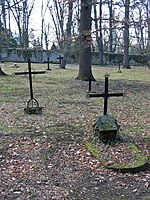
The Staatliches Bauhaus, commonly known as the Bauhaus, was a German art school operational from 1919 to 1933 that combined crafts and the fine arts. The school became famous for its approach to design, which attempted to unify individual artistic vision with the principles of mass production and emphasis on function.

Weimar is a city in the state of Thuringia, Germany. It is located in Central Germany between Erfurt in the west and Jena in the east, approximately 80 kilometres southwest of Leipzig, 170 kilometres north of Nuremberg and 170 kilometres west of Dresden. Together with the neighbouring cities of Erfurt and Jena, it forms the central metropolitan area of Thuringia, with approximately 500,000 inhabitants. The city itself has a population of 65,000. Weimar is well known because of its large cultural heritage and its importance in German history.
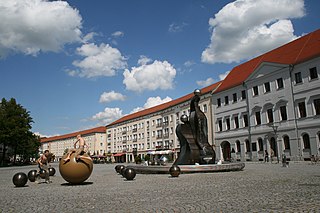
Dessau is a town and former municipality in Germany at the confluence of the rivers Mulde and Elbe, in the Bundesland of Saxony-Anhalt. Since 1 July 2007, it has been part of the newly created municipality of Dessau-Roßlau. Population of Dessau proper: 67,747.

The Bauhaus-Universität Weimar is a university located in Weimar, Germany, and specializes in the artistic and technical fields. Established in 1860 as the Great Ducal Saxon Art School, it gained collegiate status on 3 June 1910. In 1919 the school was renamed Bauhaus by its new director Walter Gropius and it received its present name in 1996. There are more than 4000 students enrolled, with the percentage of international students above the national average at around 27%. In 2010 the Bauhaus-Universität Weimar commemorated its 150th anniversary as an art school and college in Weimar.

The Haus am Horn is a domestic house in Weimar, Germany, designed by Georg Muche. It was built for the Bauhaus Werkschau exhibition which ran from July to September 1923. It was the first building based on Bauhaus design principles, which revolutionized 20th century architectural and aesthetic thinking and practice
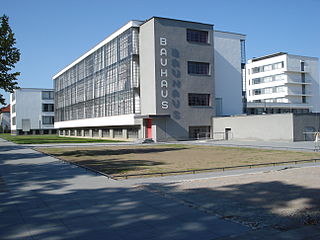
Bauhaus Dessau, also Bauhaus-Building Dessau, is a building-complex in Dessau-Roßlau. It is considered the pinnacle of pre-war modern design in Europe and originated out of the dissolution of the Weimar School and the move by local politicians to reconcile the city's industrial character with its cultural past.
The Bauhaus, formal name Staatliches Bauhaus, was a German school of design which existed from 1919 to 1933.

The Grand-Ducal Saxon Art School, Weimar was founded on 1 October 1860, in Weimar, Germany, by a decree of Charles Alexander, Grand Duke of Saxe-Weimar-Eisenach. It existed until 1910, when it merged with several other art schools to become the Großherzoglich Sächsische Hochschule für Bildende Kunst. It should not be confused with the Weimar Princely Free Drawing School, which existed from 1776 to 1930 and, after 1860, served as a preparatory school.
The Konferenz Nationaler Kultureinrichtungen (KNK) or Conference of National Cultural Institutions is a union of more than twenty cultural organizations in the former East Germany. It was established in 2002 in Halle.
Heinrich Brocksieper was a German photographer, experimental filmmaker and painter who was educated at the Bauhaus design school.

The Bauhaus Dessau Foundation is a nonprofit organization devoted to research and teaching in the field of experimental design. It was founded by the German Federal Government in 1994 and is based in the Bauhaus Dessau building in the state of Saxony-Anhalt. Its staff includes architects, town planners, sociologists, cultural scientists, artists, and art historians.

Georg Muche was a German painter, printmaker, architect, author, and teacher.
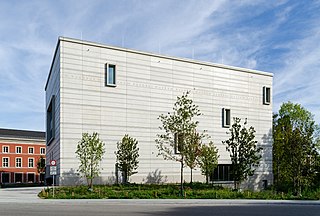
The Bauhaus Museum Weimar is a museum dedicated to the Bauhaus design movement located in Weimar, Germany. It presents the Weimar collections of the State Bauhaus, which was founded in the town in 1919. The museum is a project of the Klassik Stiftung Weimar and is located near the Weimarhallenpark. Originally opened in 1995, it is now housed in a new building since April 2019.

The ADGB Trade Union School, is a training centre complex in Bernau bei Berlin, Germany. It was built for the former General German Trade Union Federation, from 1928 to 1930. It is a textbook example of Bauhaus functionalist architecture, both in the finished product and in the analytical and collaborative approach used develop the design and complete the project. Next to the Bauhaus Dessau building, it was the second-largest project ever undertaken by the Bauhaus.

Schloss Weimar is a Schloss (palace) in Weimar, Thuringia, Germany. It is now called Stadtschloss to distinguish it from other palaces in and around Weimar. It was the residence of the dukes of Saxe-Weimar and Eisenach, and has also been called Residenzschloss. Names in English include Palace at Weimar, Grand Ducal Palace, City Palace and City Castle. The building is located at the north end of the town's park along the Ilm river, Park an der Ilm. It forms part of the World Heritage Site "Classical Weimar", along with other sites associated with Weimar's importance as a cultural hub during the late 18th and 19th centuries.

The Park an der Ilm is a large Landschaftspark in Weimar, Thuringia. It was created in the 18th century, influenced by Johann Wolfgang von Goethe, and has not been changed much, preserving a park of the period. It forms part of the World Heritage Site "Classical Weimar along with other sites across Weimar bearing testimony to the city's historical importance as a cultural hub during the Weimar Classicism movement in the late 18th and 19th centuries".
Margaretha Reichardt, also known as Grete Reichardt, was a textile artist, weaver, and graphic designer from Erfurt, Germany. She was one of the most important designers to emerge from the Bauhaus design school's weaving workshop in Dessau, Germany. She spent most of her adult life running her own independent weaving workshop in Erfurt, which was under Nazi rule and then later part of communist East Germany.

Alma Siedhoff-Buscher, born Alma Buscher, was a German designer. She trained at the Reimann School in Berlin, the Unterrichtsanstalt des Kunstgewerbemuseums Berlin and the Bauhaus.
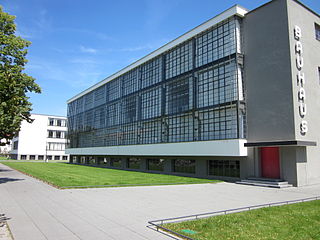
Bauhaus and its Sites in Weimar, Dessau and Bernau is a World Heritage Site in Germany, comprising six separate sites which are associated with the Bauhaus art school. It was designated in 1996 with four initial sites, and in 2017 two further sites were added.



